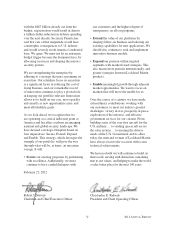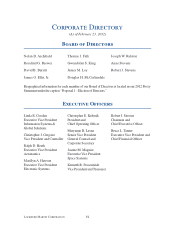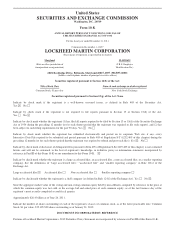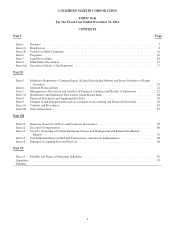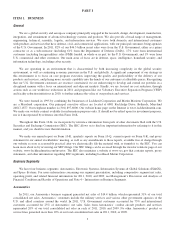Lockheed Martin 2011 Annual Report Download - page 13
Download and view the complete annual report
Please find page 13 of the 2011 Lockheed Martin annual report below. You can navigate through the pages in the report by either clicking on the pages listed below, or by using the keyword search tool below to find specific information within the annual report.Electronic Systems provides surface ship and submarine combat systems; sea-based missile defense systems; ship
systems integration; littoral combat ships; nuclear instrumentation and control systems for naval submarines, aircraft carriers,
and surface warships; air and defense missile systems; air-to-ground precision strike weapons systems; tactical missiles;
munitions; fire control and navigation systems for rotary and fixed-wing aircraft; manned and unmanned ground vehicles;
mission operations support, readiness, engineering support, and integration services; simulation and training services; and
energy programs. Electronic Systems’ major programs include:
• The Aegis Combat System, which is a fleet defense missile system for the U.S. Navy and international customers
and also a sea-based element of the U.S. missile defense system. The Aegis Combat Systems Engineering Agent
program, where we are the incumbent contractor, is being recompeted by the U.S. Navy in 2012.
• The Patriot Advanced Capability-3 (PAC-3) and Terminal High Altitude Area Defense (THAAD) air and missile
defense programs. PAC-3 is an advanced defensive missile for the U.S. Army and international customers designed
to intercept incoming airborne threats. THAAD is a transportable defensive missile system for the U.S.
Government and international customers designed to engage targets both within and outside of the Earth’s
atmosphere. The United Arab Emirates (UAE) recently selected THAAD, which represents the first international
sale for this program.
• The Multiple Launch Rocket System (MLRS), Hellfire, and Joint Air-to-Surface Standoff Missile (JASSM) tactical
missile programs. MLRS is a highly mobile, automatic system that fires surface-to-surface rockets and missiles
from the M270 and High Mobility Artillery Rocket System platforms produced for the U.S. Army and international
customers. Hellfire is an air-to-ground missile used for rotary and fixed-wing aircraft, which is produced for the
U.S. Army and international customers. JASSM is an air-to-ground missile used for fixed-wing aircraft, which is
produced for the U.S. Air Force and international customers.
• The Apache Fire Control System, which provides weapons targeting capability for the Apache helicopter for the
U.S. Army and a number of international customers.
• The Littoral Combat Ship (LCS), which is a surface combatant for the U.S. Navy designed to operate in shallow
waters. Our second LCS vessel, the Fort Worth, successfully completed its builder’s sea trials in November 2011
and is on schedule for delivery to the U.S. Navy in 2012. Construction also began on our third LCS vessel, the
Milwaukee.
• The Special Operations Forces Contractor Logistics Support Services program, which provides logistics support
services to the Special Operations Forces of the U.S. Army.
Information Systems & Global Solutions
In 2011, our IS&GS business segment generated net sales of $9.4 billion, which represented 20% of our total
consolidated net sales. IS&GS’ customers include the military services and various government agencies of the U.S. and
allied countries around the world as well as commercial and other customers. In 2011, U.S. Government customers
accounted for 93%, international customers accounted for 5%, and U.S. commercial and other customers accounted for 2%
of IS&GS’ net sales. No IS&GS’ product or service lines generated more than 10% of our total consolidated net sales in
2011, 2010, or 2009.
IS&GS provides management services, information technology solutions, and advanced technology expertise across a
broad spectrum of applications. IS&GS supports the needs of customers in human capital planning, data protection and
sharing, cyber-security, financial services, health care, energy and environment, security, space exploration, biometrics, and
transportation. IS&GS provides network-enabled situation awareness, delivers communications and command and control
capability through complex mission solutions for defense applications, and integrates complex global systems to help our
customers gather, analyze, and securely distribute critical intelligence data. IS&GS has a portfolio of many smaller contracts
as compared to our other business segments. IS&GS’ major programs include:
• The Command and Control, Battle Management, and Communications (C2BMC) contract, a program to increase
the integration of the Ballistic Missile Defense System for the U.S. Government.
• The En-Route Automation Modernization (ERAM) contract, which is a program to replace the Federal Aviation
Administration’s infrastructure with a modern automation environment that includes new functions and
capabilities.
• The Hanford Mission Support contract, which provides infrastructure and site support services to the Department
of Energy.
• The National Science Foundation’s U.S. Antarctic Support program, which was awarded in December 2011,
manages sites and equipment to enable universities, research institutions, and federal agencies to conduct scientific
research in the Antarctic.
5






